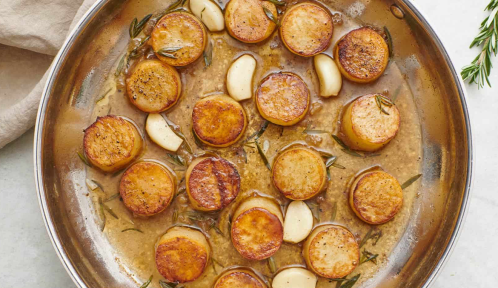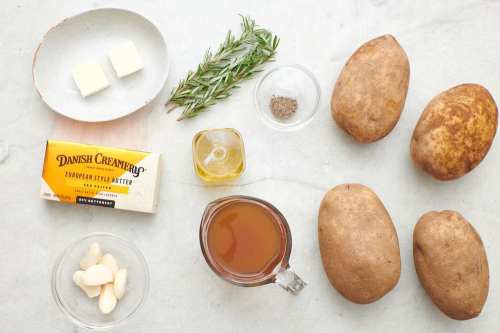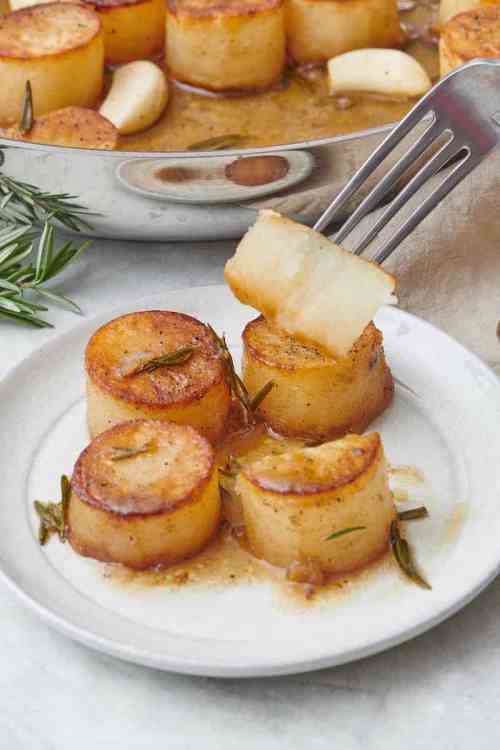Our editors independently select these products. Making a purchase through our links may earn Well+Good a commission
Meet Melting Potatoes, the Golden Child of Easy, Gut-Friendly Recipes That Solely Requires Pantry Staples
Discover how to make these gut-healthy melting potatoes, which is essentially the golden child of all nourishing potatoes.

Nourishing, delicious, soul-soothing: What more could you ask for from a humble vegetable? Also considered one of the most affordable good-for-you foods on the market, there’s so much more that can—and should—be done with a potato than turning them into mash or fries.
Experts in This Article
recipe developer and content creator behind Feel Good Foodie
If you ask Yumna Jawad, the creator behind Feel Good Foodie, melting potatoes (a popularized-by-Pinterest recipe technique for what professional chefs refer to as fondant potatoes) should be at the top of your Potato Recipe To-Do List. Melting potatoes is a term that refers to potatoes that get pan-fried and then braised in delicious broth and aromatics. Translation: Browned and buttery spuds that crunch when you bite in, but then melt blissfully in your mouth. Melting potatoes are “the kind of dish that turns an ordinary weeknight dinner into something special,” says Jawad. “They’ve got this amazing texture—think crisp on the outside and tender on the inside.”
Ahead, discover the magic of melting potatoes, including how to make melting potatoes at home with nothing more than a few pantry staples (think: russet potatoes, olive oil, veggie broth, and garlic).
Why you should be making melting potatoes
Indeed, many potato recipes involve nothing more than a spud and a few simple pantry staple ingredients. (And this one is no different.) What sets melting potatoes apart from other delicious spud-based dishes is the cooking technique applied. In this case, we’re focusing on making what’s known in culinary school as fondant potatoes, a simple preparation where same-sized, cylindrically-cut potatoes are slowly braised, partially submerged in liquid infused with aromatics (like stock, butter, garlic, and rosemary). The result is a soft and chewy potato with a crispy, golden top, and a fork-tender, creamy bottom.
Same-sized, cylindrically-cut potatoes are slowly braised, partially submerged in liquid infused with aromatics (like stock, butter, garlic, and rosemary). The result is a soft and chewy potato with a crispy, golden top, and a fork-tender, creamy bottom.
Of course, we can’t go without delving into the nutritional value of potatoes. For starters, one large raw russet potato contains nearly five grams of fiber, 1,540 milligrams of potassium (more than three times as much as what you’d get from a banana!), and 21 milligrams of vitamin C. And although gut-healthy butter may sound like an oxymoron, gastroenterologists say that butyrate, a short-chain fatty acid (SCFA) found in foods like, ahem, butter (!), can actually help support your microbiome.
Finally, although your good ol’ white, russet, and yellow potatoes varieties contain a considerable amount of benefits, if you’re looking to up the ante in terms of nutritional value, you can always swap the russets in this recipe for even more nourishing spuds, like longevity-boosting Japanese sweet potato, antioxidant-rich purple sweet potato, or ube, purple yams. (Keep in mind that cooking times and consistency will vary depending on which option you chose.)

5 tips for making the best melting potatoes
To master this fondant aka melting potato recipe, Jawad says it boils down to (pun intended) these five simple tips:
1. Use high-quality ingredients
As is the case with most simple and minimal-ingredient recipes, you’ll want to focus on using high-quality ingredients that’ll help ensure your final recipe is as nutritious and delicious as possible. For this recipe, Jawad says you’ll want to opt for Danish Creamery’s European-Style Sea Salted Butter. “I know the flavor I’m going to get is consistent and rich, without overpowering the dish. The butter plays a huge role in achieving that perfect balance between crisp and tender, all while bringing a richness that ties the whole dish together.” (Fine, twist my arm.)
2. Try and find similar-sized potatoes
When making fondant potatoes, be sure to cut potatoes into same-sized cylindrical shapes in order to ensure even and consistent cooking times. In order to do so, Jawad says it’s best to start off with russet potatoes that are at least two inches wide in diameter, which will make cutting the spuds into the same size easier. “This allows you to peel them and use a cookie cutter to cut them into pretty round shapes,” she says.
3. Use a cookie cutter to shape the potatoes
As Jawad previously mentioned, a cookie cutter will not only make your life easier (we’re talking just 10 minutes of prep work), it’ll make the final dish even prettier, too. “Use a cookie cutter. I saw [recipe developer] Carolina Gelen’s video using a cookie cutter to make even-shaped fondant potatoes, and I think it makes them look extra special and delicious,” she says. “My cookie cutter was about 1.75 inches which was the perfect size.” And, if you use a cookie cutter, Jawad recommends saving the scraps for making hashbrowns or throwing them into a Creamy Vegetable Soup. We love a zero-waste food moment.
Additional clever ways to use your leftover veggie scraps, according to Jawad: air fry or compost ‘em. “Mix potato peels with a few tablespoons of oil and bake in the oven at 425ºF, and add salt and spices like smoked paprika or celery salt for a crispy treat. You can even try them in the air fryer,” she says.
Meanwhile, you can also go the composting route. Jawad recommends saving your veggie scraps (and eggshells!) and mixing them in a bin or pit outside with brown material—defined as yard scraps like dry leaves or brown paper—which decomposes and makes a nutritious spread for plants in your yard.
“Mix potato peels with a few tablespoons of oil and bake in the oven at 425ºF, and add salt and spices like smoked paprika or celery salt for a crispy treat. You can even try them in the air fryer.”
—Yumna Jawad, creator, Feel Good Foodie
4. Be sure to dry your potatoes thoroughly first
Step number one is cleaning your spuds, which according to the Centers for Disease Control and Prevention (CDC) entails washing or scrubbing the veggie under running water (even if you don’t plan on eating the peel). After this crucial step, you’ll want to thoroughly dry the potatoes, especially once they’re peeled and sliced. “Make sure the potatoes are dry. After you peel and cut the potatoes, pat them dry with a paper towel to remove any excess moisture. This will help them sear better on the skillet,” Jawad says.
5. Don’t overcrowd the pan
To achieve that beautiful golden crust, Jawad sears the potatoes on both sides before adding the braising liquid. However, in order to get that chef-worthy crust and color, the recipe developer says it’s imperative that you don’t overcrowd the pan, and rather work in small batches at a time. “To get a good sear on the potatoes and make sure that they don’t steam in the oven, make sure to keep space between the potatoes,” Jawad says.

Fondant melting potatoes recipe
Yields 4 servings
Ingredients4 large russet potatoes peeled and cut into 1-inch thick rounds (about 2-inch wide)2 Tbsp Danish Creamery European Style Sea Salted Butter2 Tbsp olive oil1/2 Tsp salt1/2 Tsp black pepper6 garlic cloves2 sprigs fresh rosemary2 cups vegetable broth
1. Preheat the oven to 400°F. Cut each potato widthwise into about 4-6 sections, each about 1-2 inches wide. Use a cookie cutter about 2-inches wide to cut each section into a potato round. Save the edges for another use. Dry the potatoes very well using a paper towel.
2. In an oven-safe skillet, heat the butter and olive oil over medium-high heat. Add the potato rounds and cook them for about 5-7 minutes on each side, or until they are nicely browned and crispy.
3. Turn off the heat. Season with salt and pepper, and add the garlic and fresh rosemary. Carefully pour the vegetable broth into the skillet. Spoon some of the broth over the potatoes.
4. Transfer the skillet to the preheated oven and let the potatoes braise for about 20-25 minutes, or until they are fork-tender and cooked through. The broth will reduce and create a thick sauce.
5. Spoon the sauce over the potatoes and serve immediately.
Discover the benefits of potatoes, according to a registered dietitian:
Sign Up for Our Daily Newsletter
Get all the latest in wellness, trends, food, fitness, beauty, and more delivered right to your inbox.
Got it, you've been added to our email list.










